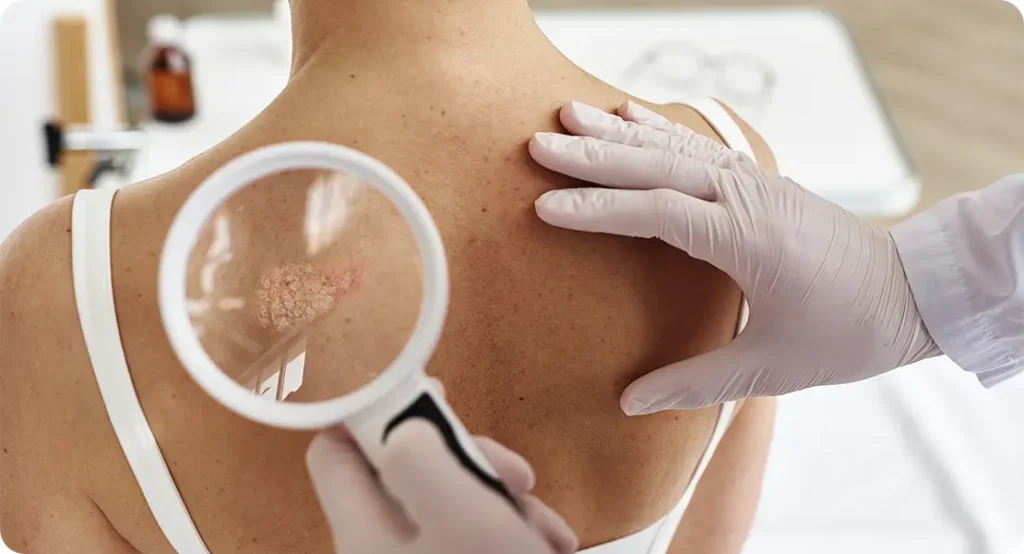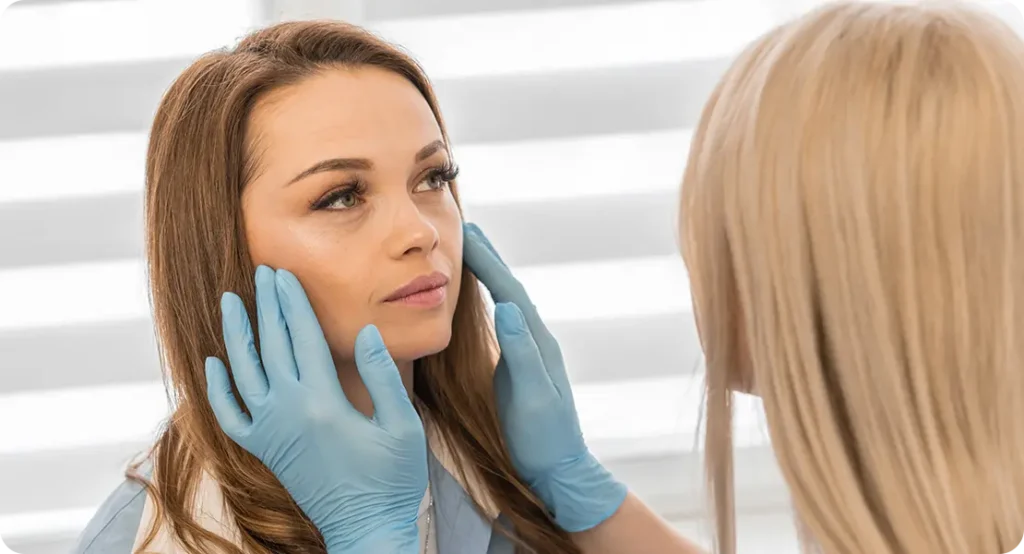Noticing changes in your skin can be unsettling especially when you’re not sure what’s causing them. A patch of skin that suddenly appears darker or lighter, becomes rough to the touch, develops new texture, or simply looks unusual can easily spark concern. While many skin changes are harmless and temporary, others can point to underlying conditions that need medical attention.
Skin is your body’s largest organ and it’s constantly renewing itself, responding to external factors like sun exposure, allergens, and irritants. So, it’s completely normal for small changes to occur from time to time. However, when a patch of skin keeps evolving, doesn’t heal, or seems unusual for your body, it’s important to take note.
In this guide, we’ll walk you through the types of skin changes you should pay attention to, the possible causes behind them, and how to decide when it’s time to see a doctor or dermatologist. Some changes may be cosmetic and easily treatable, while others could signal something more serious such as a skin condition, infection, or even skin cancer.
Being informed is the first step toward taking care of your skin. Whether the change is subtle or significant, knowing what to look out for can give you peace of mind and empower you to act early if necessary.
Remember, your skin often reflects what’s going on inside your body. Hormonal shifts, stress, nutritional deficiencies, autoimmune responses, and chronic conditions like diabetes or eczema can all manifest through visible skin changes. That’s why it’s important not to ignore a persistent patch that seems out of the ordinary even if it doesn’t hurt or itch. Early detection and proper diagnosis can make a big difference in managing potential skin issues effectively.
1. Look for These Key Skin Changes
Not every change in your skin means something is wrong but some shifts can serve as early warning signs of underlying health concerns. That’s why it’s essential to stay alert and regularly monitor your skin for any patches or spots that seem different from the rest. Subtle changes might not seem like a big deal at first, but over time, they can offer important clues about what’s going on beneath the surface.
Start by paying attention to patches of skin that are evolving in any way whether it’s a shift in colour, shape, size, texture, or sensation. These transformations can happen gradually over weeks or months, or they may emerge more suddenly. In either case, staying observant and acting early can make all the difference in catching potential issues before they become more serious.
Here are some specific signs that may indicate a problem and should prompt further attention:
- Redness or darkening: If a patch of skin becomes red, purple, brown, or noticeably darker than the surrounding area, it may point to underlying inflammation, a pigmentation disorder, or in some cases, an early sign of skin cancer such as melanoma. Pay special attention if the colour seems to deepen over time or spreads beyond its original border.
- Scaly, rough, or raised texture: A patch that feels dry, flaky, crusty, or thicker than usual could suggest a chronic skin condition like eczema, psoriasis, or actinic keratosis. These areas might also feel bumpy or appear slightly raised compared to the surrounding skin. Don’t ignore spots that keep recurring, especially if they crack, peel, or become painful.
- Patches that itch, bleed, or ooze: Occasional itching might not be concerning on its own, but when it’s accompanied by other symptoms like persistent irritation, bleeding, or oozing fluid it’s time to take a closer look. These signs may suggest an ongoing inflammatory issue or even an infection, particularly if they don’t improve with over-the-counter treatments.
- Spots that don’t heal after a few weeks: Any area of skin that resembles a wound or sore but fails to heal within a reasonable period deserves medical attention. This is especially true if the spot repeatedly forms a scab, bleeds easily, or continues to change in appearance. Such lesions could be a sign of basal or squamous cell carcinoma and should be evaluated by a dermatologist.
If you’ve noticed any of these changes, don’t dismiss them or assume they’ll go away on their own. It’s a good idea to document the patch with clear photos to track any progression over time. Make note of when you first observed the change and whether it’s evolving. These details can be incredibly helpful during a consultation with a dermatologist or skin specialist. Getting professional advice early can ensure that any potential issue is addressed before it becomes more complex or harder to treat.
2. Common Causes (and When to Worry)

There are many reasons why a patch of skin might look or feel different and thankfully, the majority are harmless and easily treatable. From mild irritation to chronic skin conditions, the skin can react in a variety of ways to internal and external triggers. Understanding the most common causes can help you make sense of what might be going on and whether it requires further attention.
Some of the most frequent, non-serious causes include:
- Eczema (atopic dermatitis): This is a chronic inflammatory condition that leads to red, itchy, and dry patches, often on the elbows, knees, or face. It can flare up due to allergens, stress, or changes in weather. While uncomfortable, it usually responds well to moisturisers, steroid creams, and avoiding known triggers.
- Contact dermatitis: Occurs when the skin comes into direct contact with an irritant or allergen, such as certain soaps, detergents, or metal jewellery. It often causes redness, itching, and sometimes blistering. Removing the irritant typically allows the skin to heal.
- Fungal infections: Ringworm, athlete’s foot, and yeast infections are common examples. These often present as red, itchy, circular patches and can appear on various parts of the body. Antifungal creams usually clear them up, but they may return if not fully treated.
- Sun damage: Extended exposure to the sun’s UV rays can lead to dark spots, dryness, and rough patches over time. While often cosmetic, chronic sun exposure increases the risk of more serious conditions and should be managed with sun protection.
- Allergic reactions: Skin can react suddenly to a new skincare product, detergent, fabric, or even food. The resulting patch may be red, itchy, or swollen but typically improves once the allergen is removed.
These conditions are generally manageable with over-the-counter treatments, lifestyle changes, or prescribed medications. However, if the patch doesn’t improve after a few weeks or continues to evolve, it could be a sign of something more serious.
When to Take It More Seriously
Some skin changes should prompt immediate attention, especially if they show signs of progression or resistance to typical treatments. Persistent patches that grow, change colour, bleed, or become increasingly uncomfortable could point to more concerning conditions, such as:
- Actinic keratosis: These are dry, scaly, or crusty patches that usually appear on sun-exposed areas like the face, scalp, or hands. They result from years of UV exposure and are considered precancerous, meaning they have the potential to develop into squamous cell carcinoma if left untreated. Though they may feel like minor blemishes, they shouldn’t be ignored.
- Skin cancers: These include both melanoma and non-melanoma types (basal cell carcinoma and squamous cell carcinoma). Warning signs to watch for include:
- A spot that’s asymmetrical or has irregular borders.
- Changes in colour especially if multiple colours appear within the same patch.
- Growth over time or failure to heal.
- Bleeding, crusting, or tenderness.
Early detection is key. When caught soon enough, most skin cancers can be treated effectively with minimal intervention. - Autoimmune and inflammatory skin conditions: Chronic disorders like psoriasis, lichen planus, and vitiligo may not always be urgent, but they require proper diagnosis and long-term management. These conditions often produce patches that are itchy, discoloured, raised, or scaly and they tend to recur or spread over time. Because symptoms can mimic other skin issues, a professional assessment is often necessary to determine the cause and course of treatment.
So When Should You Worry?
The key is to observe how the skin patch behaves over time. Ask yourself:
- Is it growing in size or changing shape?
- Has the texture become more rough, scaly, or bumpy?
- Is the colour shifting getting darker, redder, or showing multiple hues?
- Does the patch itch persistently, bleed, or ooze?
- Have any home remedies or topical treatments failed to work?
If the answer to any of these questions is yes, it’s wise not to delay further investigation. Skin that continues to evolve in concerning ways should be checked by a medical professional.
3. Don’t Try to Self-Diagnose with Google
We’ve all done it typed symptoms into a search bar, hoping for a quick answer. But when it comes to your skin, self-diagnosing based on internet photos or forum threads can be more confusing than helpful. That’s because skin conditions often look different from person to person depending on skin tone, age, severity, and even lighting in photos. What looks like a harmless rash in one case could be something more serious in another and vice versa.
Google can be a helpful starting point for general education, but it can’t take into account your personal medical history, symptoms, or subtle visual cues that a trained professional would notice. Relying too heavily on online resources can lead to misdiagnosis, inappropriate treatment, and unnecessary anxiety.
Instead of trying to match your symptoms with online images, it’s smarter to:
- Track changes over time – Keep a log of when the patch first appeared and how it evolves.
- Take regular photos – Use natural lighting and capture different angles to help your doctor assess progression.
- Note symptoms – Itching, burning, pain, bleeding, or crusting are important clues.
- Avoid self-treating – Don’t start over-the-counter creams or home remedies without knowing what you’re treating.
- Consult a professional – A dermatologist can provide a diagnosis and treatment plan tailored to your condition.
When it comes to your skin, trusting a trained expert is always safer and far less stressful than navigating the sea of search results on your own.
While Google and health-related websites can be a helpful place to start for general information or learning about possible causes, they should never be your final stop. Self-diagnosing based on a couple of images and generic symptoms can lead to:
- Using the wrong treatments or medications
- Ignoring something that actually requires urgent care
- Panicking over a benign issue
- Delaying a proper diagnosis and worsening the condition
4. A Biopsy Isn’t Always Required But It Might Help
Hearing the word biopsy can be a little intimidating, but in dermatology, it’s a common and often straightforward procedure. If your dermatologist notices a skin patch that appears unusual, persistent, or potentially serious, they might recommend a biopsy to determine exactly what’s going on. This involves removing a small sample of skin tissue, which is then examined under a microscope in a lab.
Most skin biopsies are quick, minimally invasive, and performed under local anaesthetic, meaning the area is numbed but you stay fully awake. The entire process typically takes under 15 minutes, and you can usually go about your day afterward with just a small bandage in place. It’s a valuable diagnostic tool that can confirm or rule out conditions like skin cancer, autoimmune disorders, or chronic inflammatory skin diseases.
Here’s what you should know about skin biopsies:
- They’re not always needed – Many skin conditions can be diagnosed visually or with non-invasive tools.
- There are different types – Including shave, punch, and excisional biopsies your dermatologist will choose the best method.
- They provide clarity – A biopsy can confirm a diagnosis with certainty, guiding the right course of treatment.
- Recovery is minimal – You may feel slight discomfort or tenderness for a day or two, but complications are rare.
- Scarring is usually small – Especially with proper wound care and depending on the biopsy type and location.
While the idea of a biopsy might sound serious, in many cases, it’s simply a precautionary step. Think of it as a way to get a clearer picture and ensure you’re on the right track whether the issue turns out to be minor or something that needs further attention.
5. Early Action Can Make All the Difference

When it comes to skin health, waiting and watching isn’t always the best strategy. Even if the patch ends up being something harmless like a mild rash or pigmentation issue getting it looked at by a professional can offer reassurance and stop you from worrying unnecessarily. And if it does turn out to be something more serious, early diagnosis often means simpler, less invasive treatment, better outcomes, and faster recovery.
Skin issues rarely resolve overnight, and some conditions can worsen over time if left untreated. That’s why acting early is so important. Whether it’s a growing mole, a stubborn rough patch, or a mark that just seems different, listening to your gut is often the smartest move.
Here’s why it’s worth taking action sooner rather than later:
- Peace of mind – Knowing what you’re dealing with can reduce stress and anxiety.
- Less aggressive treatment – Early-stage conditions are often easier to manage or reverse.
- Prevention of spread – Some infections or inflammatory conditions can worsen or spread if ignored.
- Reduced risk of scarring – Timely care can prevent long-term damage to the skin.
- Better health outcomes – Especially for conditions like skin cancer, where early detection is key.
Your skin is your body’s largest organ and your first line of defence so if something doesn’t look or feel quite right, trust your instincts and seek advice from a qualified dermatologist. Acting now could save you time, discomfort, and worry later.
Final Thought: When in Doubt, Get It Checked
Noticed a patch of skin that’s changed? It’s always better to be safe than sorry. A quick visit with a qualified dermatologist can give you clarity and keep your skin health on track. Even if it turns out to be something minor, getting a professional opinion removes the guesswork and allows you to move forward with confidence. Your skin is too important to ignore trust your instincts and get the care you need. Feel free to contact us to schedule a consultation with one of our experienced dermatologists.
Reference:
- Skin Cancer Foundation (2023). “When to Worry About a Skin Spot.” Available at: https://www.skincancer.org/
- British Association of Dermatologists (2024). “Actinic Keratoses.” Available at: https://www.bad.org.uk/
- DermNet NZ (2024). “Skin changes.” Available at: https://dermnetnz.org/
- American Academy of Dermatology (2024). “Rashes and skin conditions.” Available at: https://www.aad.org/
